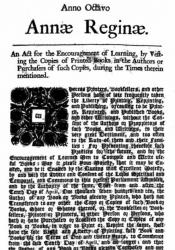The Statute of Anne
The Statute of Anne, also known as the Copyright Act 1710, was the first statute to provide for copyright regulated by the government and courts, rather than by private parties. It was formally put as "An Act for the Encouragement of Learning, by Vesting the Copies of Printed Books in the Authors or Purchasers of Copies, during the Times therein mentioned."
Prior to the statute's enactment in 1710, copying restrictions were authorized by the Licensing of the Press Act 1662. These restrictions were enforced by the Stationers' Company, a guild of printers given the exclusive power to print—and the responsibility to censor—literary works. The censorship administered under the Licensing Act led to public protest; as the act had to be renewed at two-year intervals, authors and others sought to prevent its reauthorisation. In 1694, Parliament refused to renew the Licensing Act, ending the Stationers' monopoly and press restrictions.
The Statute of Anne prescribed a copyright term of 14 years, with a provision for renewal for a similar term, during which only the author and the printers to whom they chose to license their works could publish the author's creations. Following this, the work's copyright would expire, with the material falling into the public domain. Despite a period of instability known as the Battle of the Booksellers when the initial copyright terms under the Statute began to expire, the Statute of Anne remained in force until the Copyright Act 1842 replaced it.

